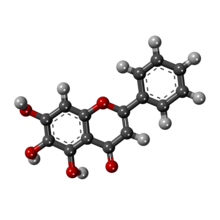Baicalein
 | |
 | |
| Đồng nghĩa | Biacalein; Noroxylin |
|---|---|
| Các định danh | |
Tên IUPAC
| |
| Số đăng ký CAS | |
| PubChem CID | |
| IUPHAR/BPS | |
| ChemSpider | |
| Định danh thành phần duy nhất | |
| KEGG | |
| ChEBI | |
| ChEMBL | |
| ECHA InfoCard | 100.164.911 |
| Dữ liệu hóa lý | |
| Công thức hóa học | C15H10O5 |
| Khối lượng phân tử | 270,24 g·mol−1 |
| Mẫu 3D (Jmol) | |
SMILES
| |
Định danh hóa học quốc tế
| |
Baicalein (5,6,7-trihydroxyflavone) là một flavone, một loại flavonoid, ban đầu được phân lập từ rễ của Scutellaria baicalensis và Scutellaria lateriflora. Nó cũng được báo cáo trong Oroxylum notifyum (hoa loa kèn Ấn Độ) và Thyme [1]. Nó là aglycone của baicalin. Baicalein là một trong những hoạt chất của Sho-Saiko-To, một chất bổ sung thảo dược Trung Quốc được cho là giúp tăng cường sức khỏe gan.
Baicalein, cùng với baicalin tương tự của nó, là một bộ điều biến allosteric tích cực của vị trí benzodiazepine và/hoặc vị trí không chứa benzodiazepine của thụ thể GABA <sub id="mwFw">A.</sub> [2][3][4][5][6][7] Nó hiển thị độ chọn lọc của kiểu con cho các thụ thể GABA A liên kết với tiểu đơn vị α<sub id="mwGQ">2</sub> và α<sub id="mwGw">3</sub>.[8] Theo đó, baicalein cho thấy tác dụng giải lo âu ở chuột mà không có tỷ lệ an thần hoặc suy tủy.[7][8][9] Người ta cho rằng baicalein, cùng với các flavonoid khác, có thể làm tăng tác dụng giải lo âu của S. baicalensis và S. lateriflora.[10][11] Baicalein cũng là một chất đối kháng của thụ thể estrogen, hoặc một chất chống ung thư.[11]
Flavonoid đã được chứng minh là ức chế một số loại lipoxygenase [12] và hoạt động như một chất chống viêm.[13] Nó có tác dụng chống đông máu đối với sự tăng sinh do ET-1 gây ra đối với sự tăng sinh tế bào cơ trơn của động mạch phổi thông qua sự ức chế biểu hiện kênh TRPC1.[14] Tác dụng chống trầm cảm có thể cũng đã được quy cho baicalein trong nghiên cứu động vật.[15]
Baicalein là chất ức chế CYP2C9,[16] một loại enzyme của hệ thống cytochrom P450 giúp chuyển hóa thuốc trong cơ thể.
Một dẫn xuất của baicalin là một chất ức chế prolyl endopeptidase được biết đến.[17]
Baicalein đã được chứng minh là ức chế sự hình thành màng sinh học Staphylococcus aureus và hệ thống cảm biến đại biểu trong ống nghiệm.[18]
Glycoside
[sửa | sửa mã nguồn]Tetuin là 6- glucoside của baicalein.
Xem thêm
[sửa | sửa mã nguồn]- Danh sách các hợp chất có carbon số 15
Tham khảo
[sửa | sửa mã nguồn]- ^ Matsumoto, Takumi (2008). Phytochemistry Research Progress. ISBN 9781604562323.
- ^ Wang H, Hui KM, Xu S, Chen Y, Wong JT, Xue H (2002). “Two flavones from Scutellaria baicalensis Georgi and their binding affinities to the benzodiazepine site of the GABAA receptor complex”. Pharmazie. 57 (12): 857–8. PMID 12561253.
- ^ Hui KM, Wang XH, Xue H (2000). “Interaction of flavones from the roots of Scutellaria baicalensis with the benzodiazepine site”. Planta Med. 66 (1): 91–3. doi:10.1055/s-0029-1243121. PMID 10705749.
- ^ Zhang SQ, Obregon D, Ehrhart J, Deng J, Tian J, Hou H, Giunta B, Sawmiller D, Tan J (2013). “Baicalein reduces β-amyloid and promotes nonamyloidogenic amyloid precursor protein processing in an Alzheimer's disease transgenic mouse model”. J. Neurosci. Res. 91 (9): 1239–46. doi:10.1002/jnr.23244. PMC 3810722. PMID 23686791.
- ^ Liao JF, Wang HH, Chen MC, Chen CC, Chen CF (1998). “Benzodiazepine binding site-interactive flavones from Scutellaria baicalensis root”. Planta Med. 64 (6): 571–2. doi:10.1055/s-2006-957517. PMID 9776664.
- ^ Edwin Lowell Cooper; Nobuo Yamaguchi (ngày 1 tháng 1 năm 2004). Complementary and Alternative Approaches to Biomedicine. Springer Science & Business Media. tr. 188–. ISBN 978-0-306-48288-5.
- ^ a b de Carvalho RS, Duarte FS, de Lima TC (2011). “Involvement of GABAergic non-benzodiazepine sites in the anxiolytic-like and sedative effects of the flavonoid baicalein in mice”. Behav. Brain Res. 221 (1): 75–82. doi:10.1016/j.bbr.2011.02.038. PMID 21377498.
- ^ a b Wang F, Xu Z, Ren L, Tsang SY, Xue H (2008). “GABA A receptor subtype selectivity underlying selective anxiolytic effect of baicalin”. Neuropharmacology. 55 (7): 1231–7. doi:10.1016/j.neuropharm.2008.07.040. PMID 18723037.
- ^ Liao JF, Hung WY, Chen CF (2003). “Anxiolytic-like effects of baicalein and baicalin in the Vogel conflict test in mice”. Eur. J. Pharmacol. 464 (2–3): 141–6. doi:10.1016/s0014-2999(03)01422-5. PMID 12620506.
- ^ Awad R, Arnason JT, Trudeau V, Bergeron C, Budzinski JW, Foster BC, Merali Z (2003). “Phytochemical and biological analysis of skullcap (Scutellaria lateriflora L.): a medicinal plant with anxiolytic properties”. Phytomedicine. 10 (8): 640–9. doi:10.1078/0944-7113-00374. PMID 14692724.
- ^ a b Stefanie Schwartz (ngày 9 tháng 1 năm 2008). Psychoactive Herbs in Veterinary Behavior Medicine. John Wiley & Sons. tr. 139–. ISBN 978-0-470-34434-7.
- ^ Deschamps JD, Kenyon VA, Holman TR (tháng 6 năm 2006). “Baicalein is a potent in vitro inhibitor against both reticulocyte 15-human and platelet 12-human lipoxygenases”. Bioorg. Med. Chem. 14 (12): 4295–301. doi:10.1016/j.bmc.2006.01.057. PMID 16500106.
- ^ Hsieh CJ, Hall K, Ha T, Li C, Krishnaswamy G, Chi DS (2007). “Baicalein inhibits IL-1β- and TNF-α-induced inflammatory cytokine production from human mast cells via regulation of the NF-κB pathway”. Clin Mol Allergy. 5 (1): 5. doi:10.1186/1476-7961-5-5. PMC 2206049. PMID 18039391.
- ^ Lin Y-L, Lin R-J, Shen K-P, Dai Z-K, Chen I-J, Wu J-R, Wu B-N (2011). “Baicalein, isolated from Scutellaria baicalensis, protects against endothelin-1-induced pulmonary artery smooth muscle cell proliferation via inhibition of TRPC1 channel expression”. Journal of Ethnopharmacology. 138 (2): 373–381. doi:10.1016/j.jep.2011.09.014. PMID 21963569.
- ^ Xiong Z, Jiang B, Wu PF, và đồng nghiệp (2011). “Antidepressant effects of a plant-derived flavonoid baicalein involving extracellular signal-regulated kinases cascade”. Biol. Pharm. Bull. 34 (2): 253–9. doi:10.1248/bpb.34.253. PMID 21415537.
- ^ Si D, Wang Y, Zhou Y-H, Guo Y, Wang J, Zhou H, Li Z-S, Fawcett JP (tháng 3 năm 2009). “Mechanism of CYP2C9 inhibition by flavones and flavonols” (PDF). Drug Metabolism and Disposition. 37 (3): 629–34. doi:10.1124/dmd.108.023416. PMID 19074529. Bản gốc (PDF) lưu trữ ngày 17 tháng 12 năm 2008. Truy cập ngày 18 tháng 6 năm 2019.
- ^ Tarragó T, Kichik N, Claasen B, Prades R, Teixidó M, Giralt E (tháng 8 năm 2008). “Baicalin, a prodrug able to reach the CNS, is a prolyl oligopeptidase inhibitor”. Bioorganic and Medicinal Chemistry. 16 (15): 7516–24. doi:10.1016/j.bmc.2008.04.067. PMID 18650094.
- ^ Chen Y, Liu T, Wang K, Hou C, Cai S, Huang Y, Du Z, Huang H, Kong J, Chen Y (tháng 4 năm 2016). “Baicalein Inhibits Staphylococcus aureus Biofilm Formation and the Quorum Sensing System In Vitro”. PLOS ONE. 11 (4): e0153468. doi:10.1371/journal.pone.0153468. PMC 4851419. PMID 27128436.
